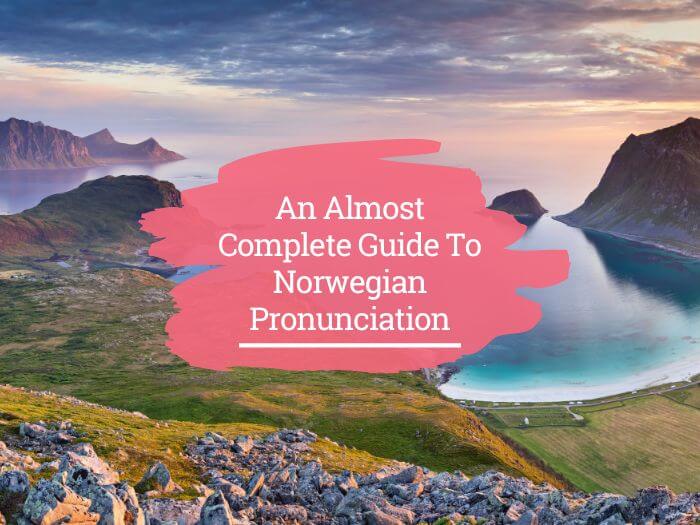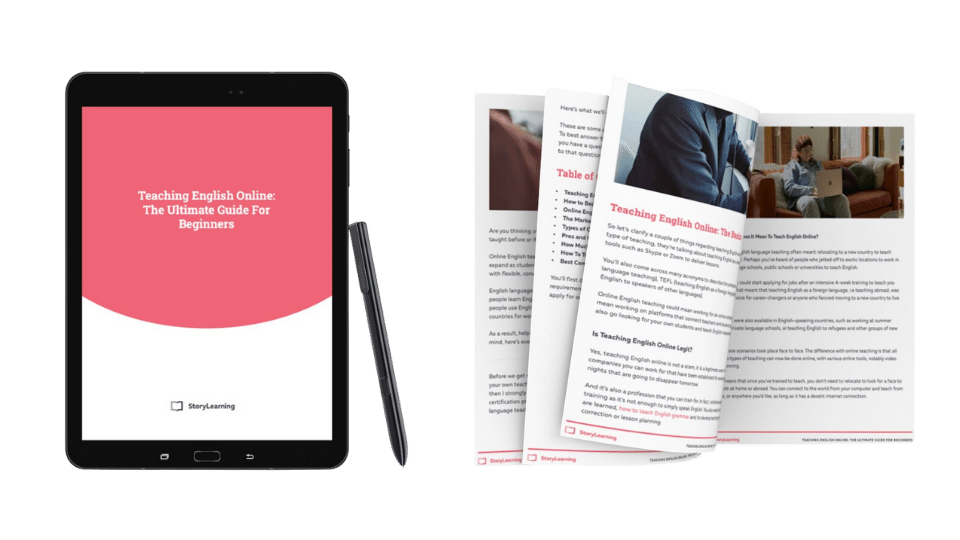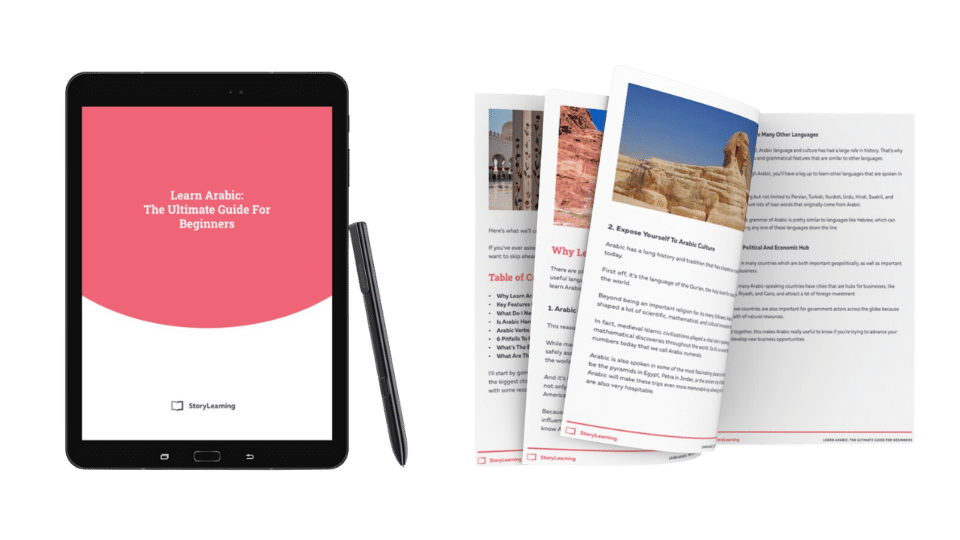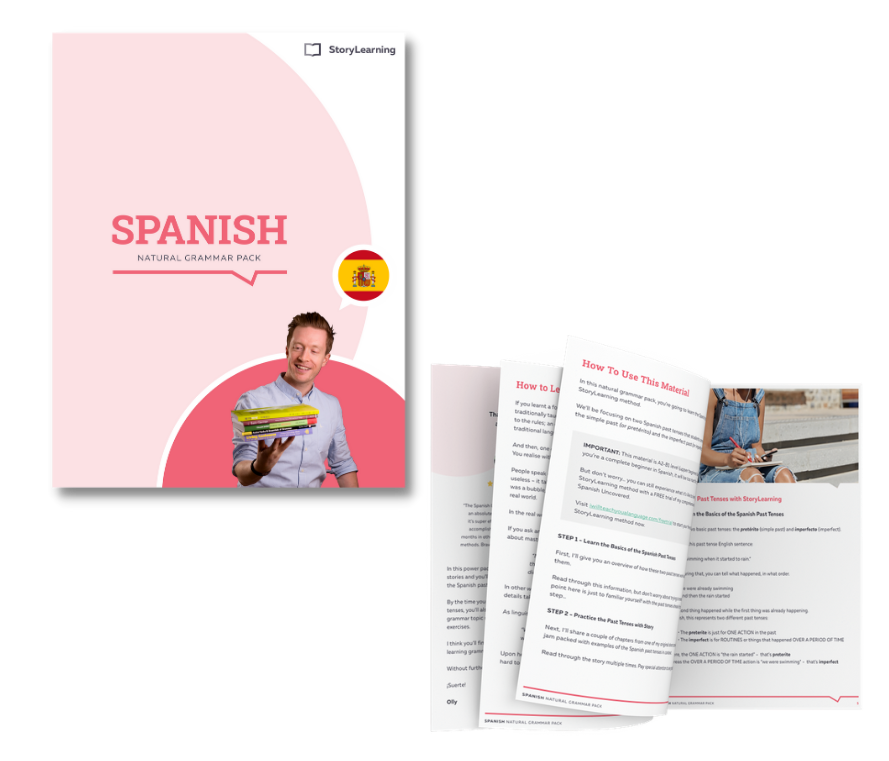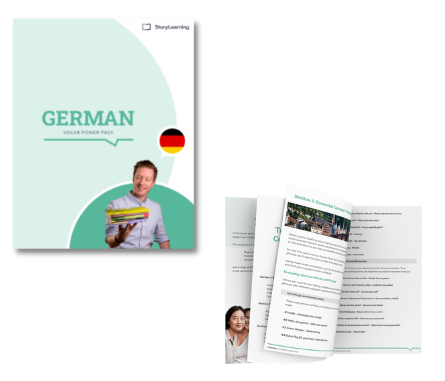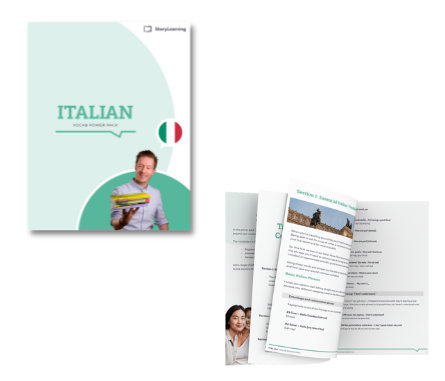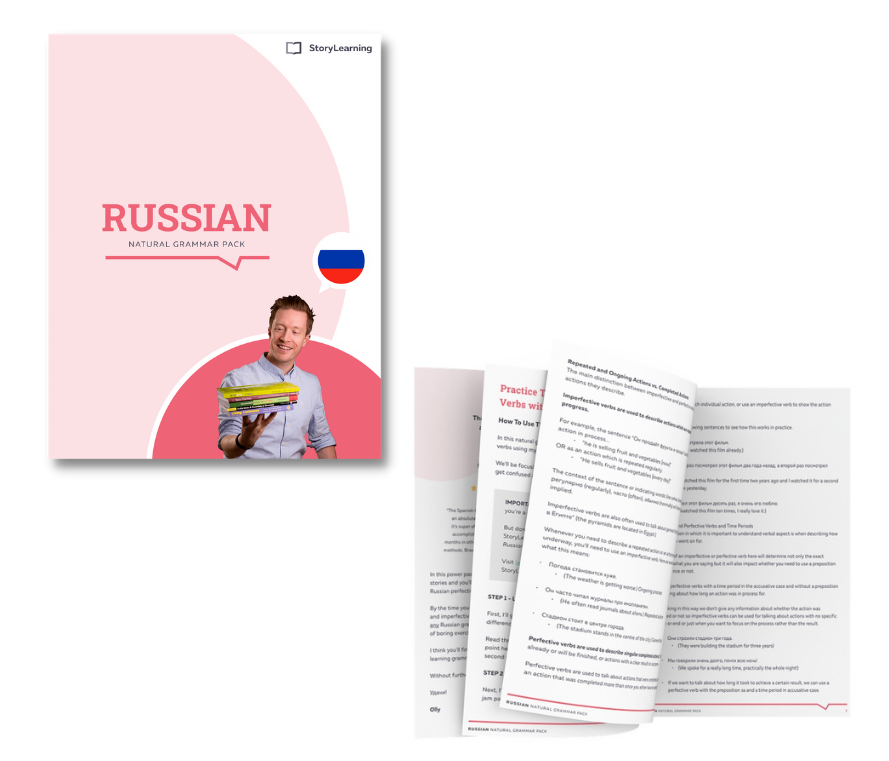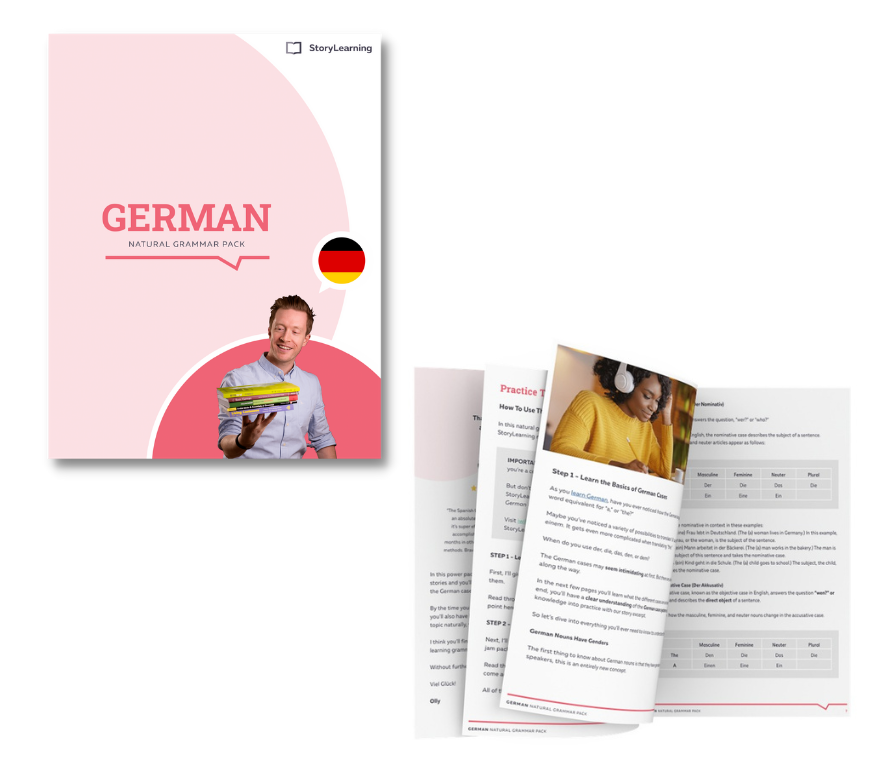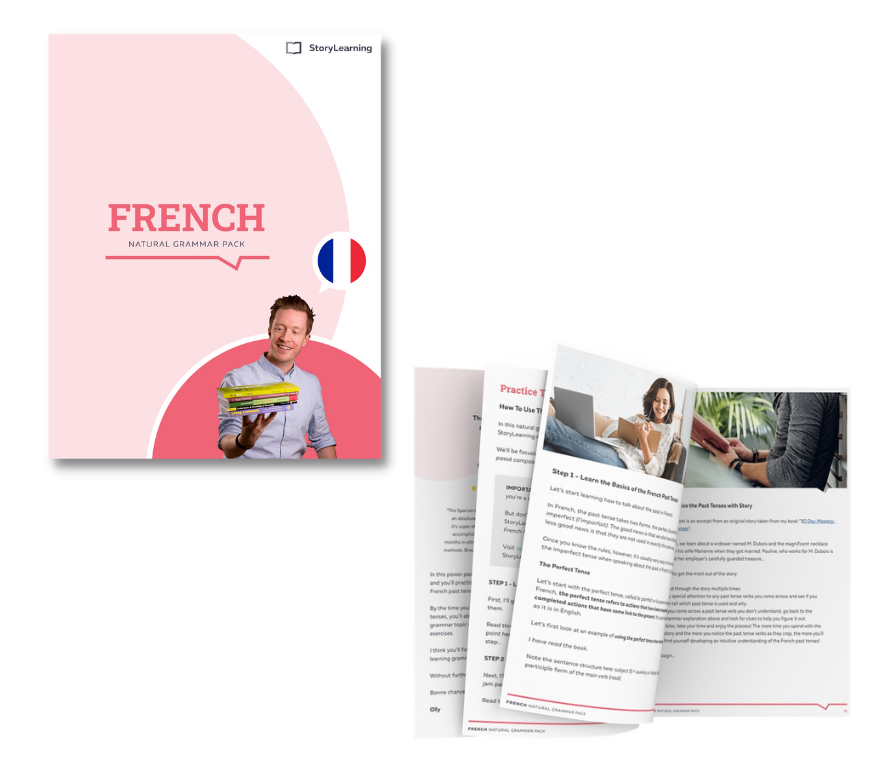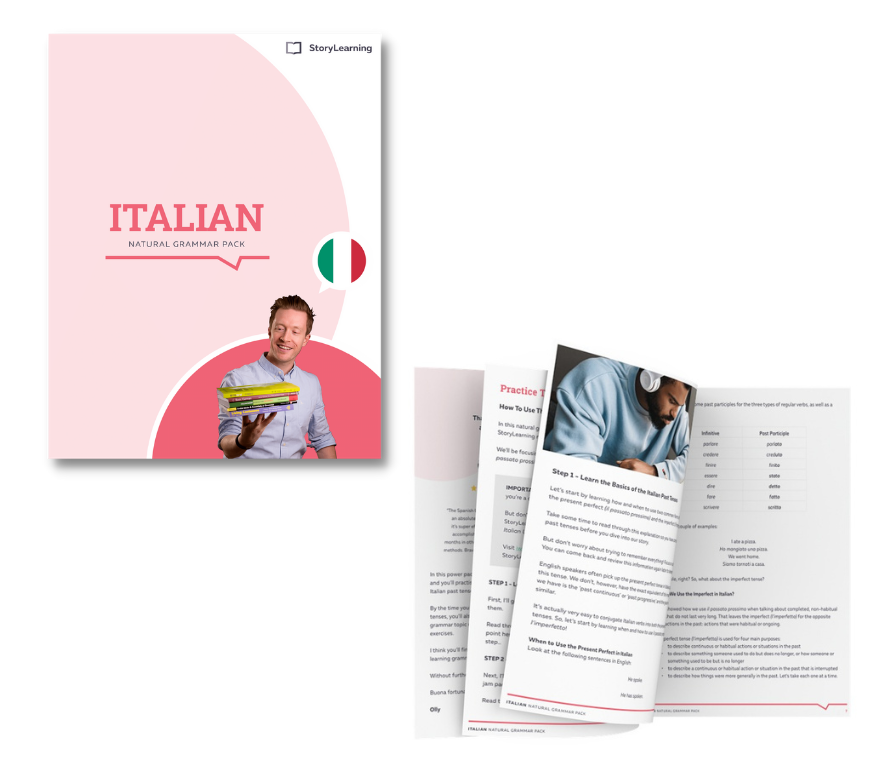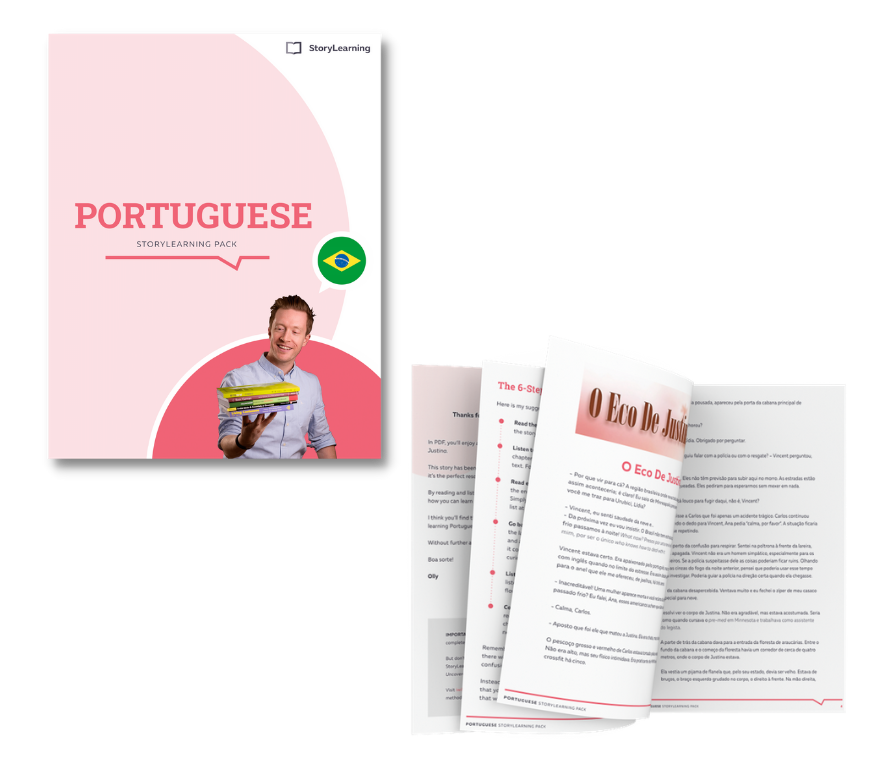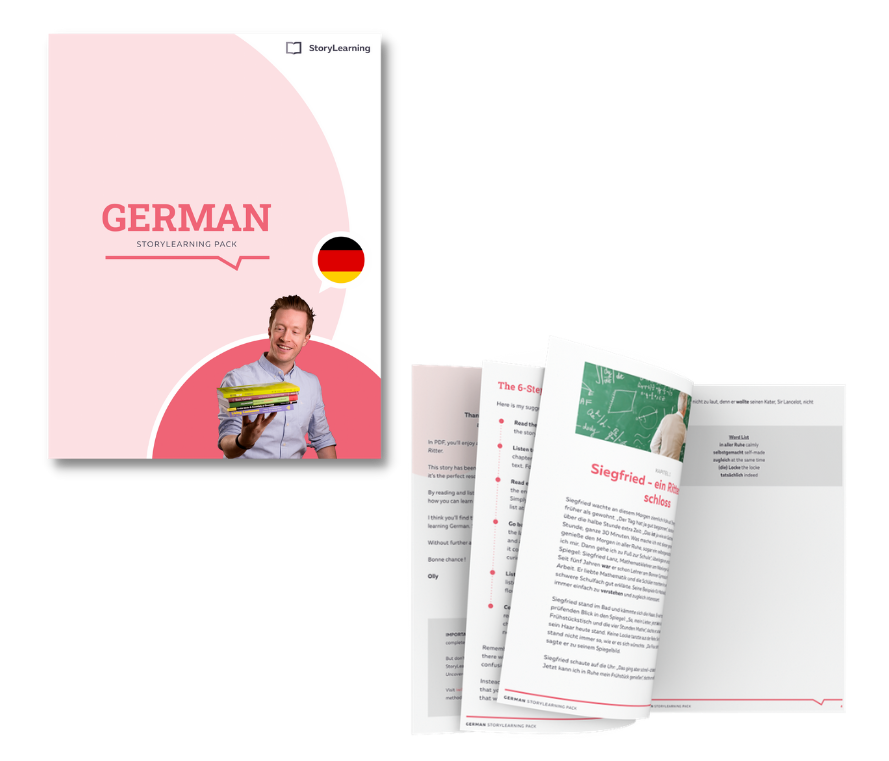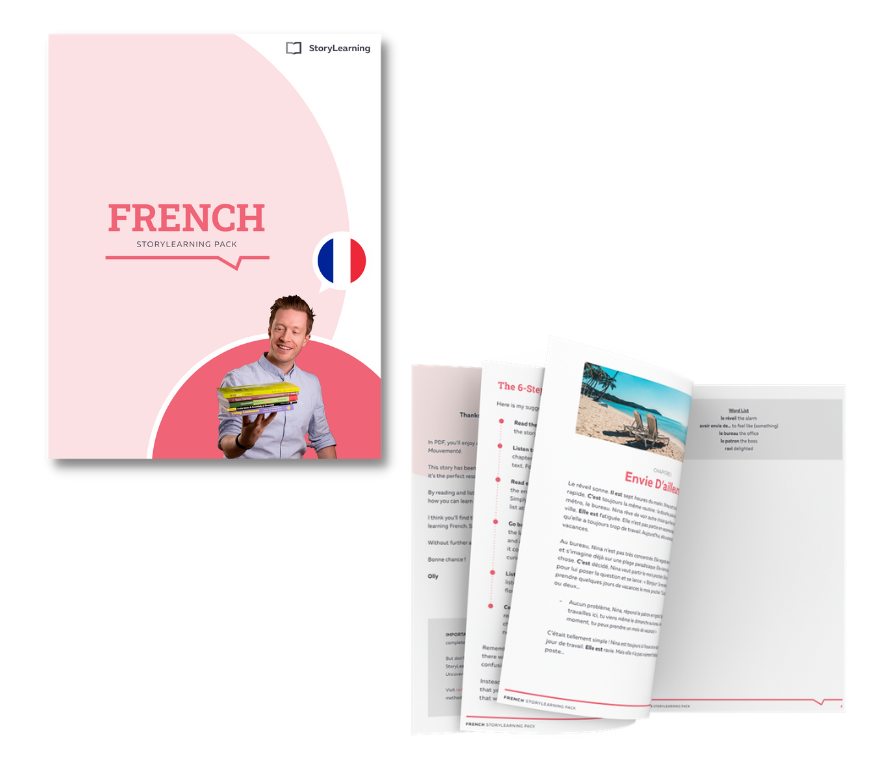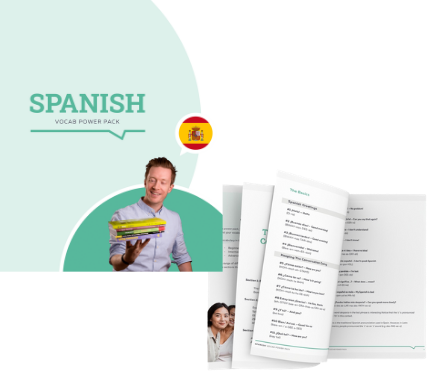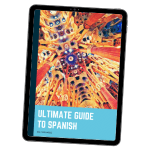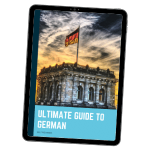There's no easy way to put this to you, but it's really impossible to give you a complete guide to Norwegian pronunciation.
In a country with hundreds, if not thousands, of Norwegian dialects, any strict pronunciation instructions would quite probably go out of the window the moment you move around Norway.
This guide, however, will give you the basics of Norwegian pronunciation and mainly refers to the Eastern Norwegian dialect.
Eastern Norwegian is spoken by more than half of the country’s population and is in most circumstances considered the ‘cleanest’ version of Bokmål, one of two Norwegian language standards, you can find.
Pro Tip
By the way, if you want to learn Norwegian fast (including Norwegian pronunciation) and have fun, my top recommendation is Norwegian Uncovered which teaches you through StoryLearning®.
With Norwegian Uncovered you’ll use my unique StoryLearning® method to learn Norwegian through story…not rules. It’s as fun as it is effective. If you’re ready to get started, click here for a 7-day FREE trial.
Table of Contents
The Physical Challenges Of Saying It Right

When we talk about the language we have learned from birth, we often use the expression ‘mother tongue’, with good reason.
The tongue is our foremost instrument when it comes to pronouncing the vocabulary of our language and we become set in our ways early on in how to use this organ during our speech so that others who speak the same language can understand us.
The moment we learn another language, these habits become tricky. Our tongue is used to going into certain positions when we pronounce certain letters or letter combination.
But a different language might have an entirely different take on how these very same letters and letter combinations should sound.
Native English speakers like to make fun of Germans being unable to pronounce the all-important ‘th’ sound, which appears in virtually all English sentences, while the French often are ridiculed for their perceived inability to speak the letter ‘h’ out loud.
However, native English speakers might also face their own distinct failures when confronted with a wide variety of typical sounds in Norwegian, which has letter combinations and diphthongs that are entirely alien to our perception of spoken language.
Here I’ll give you some of the most common traps to look out for when you try to get your head around the pronunciation of the Norwegian language.
Norwegian Pronunciation Guide
When you learn Norwegian, you need to forget what you have learned in school with regards to the alphabet. In Norwegian, the alphabet has not 26, but 29 letters, adding Æ, Ø and Å after Z.
It also has 9 vowels as opposed to the English 5 and to make matters worse, the Norwegian pronunciation of these, and the rest of the alphabet, are often wildly different from what you're used to in English.
Here's an approximate pronunciation guide for the Norwegian alphabet for English language speakers, but please note that some sounds have no clear or exact English equivalent:
| A | like the ‘a’ in hard |
| B | like the ‘be’ in believe |
| C | like the ‘ce’ in centipede |
| D | like the ‘de’ in deluge |
| E | like the ‘e’ in to lend |
| F | like the ‘ef’ in efficient |
| G | like the ‘ge’ in get |
| H | like the ‘ho’ in hope |
| I | like the ‘i’ in instinct |
| J | like the ‘ye’ in Yemen |
| K | like the ‘co’ in company |
| L | like the ‘el’ in electric |
| M | like the ‘em’ in demonstration |
| N | like the ‘en’ in entire |
| O | like the ‘o’ in song |
| P | like the ‘pe’ in petroleum |
| Q | has no equivalent. The closest would be ‘ky’ in Kyrgyzstan |
| R | like the ‘er’ in error |
| S | like the ‘es’ in Esther |
| T | like the ‘te’ in terrace |
| U | again, no equivalent here, but the ‘y’ in hymn comes pretty close |
| V | like the ‘ve’ in vengeance |
| W | the English ‘Double-U’ becomes a ‘Double-V', pronounced ‘dobbelt-ve’ |
| X | like the ‘ex’ in exorcist |
| Y | like the ‘u’ in uber |
| Z | like the ‘cet’ in cetology |
| Æ | like the ‘a’ in at |
| Ø | like the ‘i’ in bird |
| Å | like the ‘o’ in go |
If you're looking for Norwegian pronunciation videos to help you pronounce the sounds of Norwegian right, then I can recommend this one about the alphabet and pronunciation below:
Many of the vowels and consonants will change completely in spoken Norwegian as soon as you place them with different letters. Let’s begin with the Norwegian vowels, which have increased by 4 compared to the English alphabet.
The Long And The Short Of The Norwegian Vowels

As mentioned above, the Norwegian vowels are a, e, i, o, u, y, æ, ø and å.
While their pronunciation outside of a word might be as read in my guide to the Norwegian alphabet, their sound can change, depending on where in a word the vowels are placed, and depending on if it’s a long or a short vowel.
As a rule of thumb, a Norwegian vowel is pronounced long when it's followed by a single consonant. Examples would be words like klar (clear), merke (mark), bil (car), sol (sun), hus (house), lyd (sound), lærer (teacher), mørke (dark) and språk (language).
When a Norwegian vowel is followed by a double consonant, it will always be pronounced short, as in tann (tooth), venn (friend), minne (memory), tonn (ton), rulle (roll), fyll (fill), bønn (prayer), færre (less) and råtten (rotten).
In most circumstances, when a vowel is followed by two different consonants, it will be short, as in flaske (bottle), eske (box), liste (list), koster (cost), bukse (trousers), kyst (coast), løsne (loosen) and bånd (ribbon).
Yet there are quite a few exceptions, and you will have to look up some words as your Norwegian vocabulary progresses.
You might wonder why the long and the short vowel version could become an issue, especially in spoken Norwegian. We are, after all, only talking about a few nanoseconds in length during the pronunciations of the vowels.
However, when you speak, a long or short pronunciation of a vowel can change not only the meaning of a word, but the entire context of a sentence. Here are a few traps where the pronunciation of the Norwegian vowel can make a difference:
- fat (long vowel meaning barrel) turns to fatt (short vowel meaning get a grip)
- pen (long vowel meaning pretty) turns to penn (short vowel meaning pencil)
- fin (long vowel meaning fine) turns to finn (short vowel meaning find)
- buke (long vowel meaning bouquet) turns to bukke (short vowel meaning bend)
- leker (long vowel meaning play) turns to lekker (short vowel meaning tasty)
And finally, these are the two possibly most confusing Norwegian pronunciation issues many Norwegian language beginners struggle with:
- tak (long vowel meaning roof) turns to takk (short vowel meaning thank you)
- lege (long vowel meaning doctor) suddenly becomes legge (short vowel meaning adding).
Exceptions Are The Spice Of (The Norwegian) Language
If you’ve followed this blog for a while, and I hope you have, you'll know that Norwegian is a language filled with exceptions like no other.
You’ve just learned one rule and happily apply it, and then someone tells you: “No, not this one. It’s an exception”. In most circumstances, there's no reason given for the exception. It’s just the way it is, but it might make learning Norwegian just a little bit more interesting.
I promise you, however, that you will get your head around this.
The most distinctive exceptions with regards to vowel pronunciation lies in the pronouns. While you’ve just learned that vowels followed by a single consonant are pronounced long, you’ll find that this is just not the case when it comes to almost all of the Norwegian pronouns.
Jeg (I), han/hun/det (he/she/it) and dem (them) all end with a single consonant, but the vowel is pronounced short.
As these are some of the most commonly used words in the vocabulary, and the main building blocks of Norwegian sentences, you’ll learn this exception already on day 1 and there's no need to worry about remembering it.
The same happens with the frequently used modal verbs skal (shall) and vil (will) which both are pronounced with a short vowel.
Norwegian Pronunciation Of E, O And U

To make things just a little bit more complicated, you will have to get used to the various pronunciations the letters e, o and u.
- E: this vowel has three pronunciations. In general, the Norwegian ‘e’ sounds pretty close to the English ‘e’ in mend, rent or send. However, if the ‘e’ is placed in front of an ‘r’, it's usually pronounced closer to the English ‘ai’ sound as in pair or lair. Examples would be ler (laugh), mer (more) and der (there). The last pronunciation of ‘e’ is reserved to one Norwegian word: de (they), where it sounds like the ‘e’ in me.
- O: This vowel also has three different pronunciations, mainly depending on the consonants it is mixed up with. The standard Norwegian pronunciation is a long ‘oo’ as in fool or cool. The most common example of Norwegian words of this kind would be stor (big), bor (live) and the name Tor. No surprise here as there are a couple of exceptions in the not unimportant words morsom (funny) and fort (fast) where the ‘oo’ sound is pronounced fast. However, when ‘o’ is placed in front of two consonants, it changes into a short ‘o’ as in rock or lost. Norwegian words with a short ‘o’ are hoppe (jump), sokker (socks) and flott (great). There's also a third pronunciation, which is a long ‘o’ that can best be described with the English ‘oa’ sound, as in load or moat. These are exceptions and can be found in the Norwegian words tog (train), love (promise) and sove (sleeping).
- U: is generally pronounced like an English ‘y’ in mystic. Norwegian examples would be hus (house) or husker (remember). However, when it comes before the consonants -ks, -kk, -ng, -nk or -m, it will be pronounced like an English ‘ou’ as in could. Typical Norwegian words in that category would be bukse (trouser), lukke (close), tung (heavy), lunken (lukewarm) and dum (stupid).
Pronunciation Of Norwegian Diphthongs
Diphthongs are two vowels that slide into each other to make a specific sound. In Norwegian, the most common diphthongs are ‘ei’, ‘ai’, ‘au’ and ‘øy’ which each have their own pronunciation.
- Norwegian diphthong ‘ei’: This common letter combination is pronounced like the English word eye. You can find it in feil (mistake), peiling (sounding out) and lei seg (sad).
- Norwegian diphthong ‘ai’: Not as common as the others, this vowel combination can be found in hai (shark), mais (sweetcorn) and kai (quay) and sounds close to the ‘i' in line or shine!
- Norwegian diphthong ‘au’: ‘Au’ in Norwegian is pronounced like the ‘ow’ in howl and can be found in fortau (pavement), sau (sheep) and maur (ant).
- Norwegian diphthong ‘øy’: This sounds close to the oy-sound in joy or toy and is used in høy (tall), tilføy (add) and drøye (lengthy).
Strangely enough the letter combination ‘oy’ is often mentioned as a typical Norwegian diphthong, yet it only appears in loanwords – mainly from the English – where it is pronounced the same way as in English.
Not found in English are however the next letter combinations.
The Unusual Norwegian Consonant Clusters: Kj, Tj, Sj, Skj

While those pesky Norwegian vowels will most probably cause you the most problems when you try to speak Norwegian, there are also a few consonant combinations you might not have seen before.
The following clusters of consonants are the most common in the Norwegian language and while I attempt to give you some guidance here, the pronunciation of these will vary especially in the different dialects you find in Norway.
They all are predominately found at the beginning of words in the noun, verb and adjective categories.
- Kj: The sound made by pronouncing ‘kj’ has no real English equivalent. The closest you come to pronouncing it is by softening your ‘ch’ you find in check or chocolate. This cluster is found in a lot of words in the Norwegian vocabulary, from kjole (dress) and kjæreste (lover) to kjølig (cold) and kjører (drive).
- Tj: Once you’ve learned the ‘kj’ sound above, you just add a hint of a ‘t’ as in witch or watch and you will reach the sound of ‘tj’. It appears nowhere near as often in the Norwegian language as ‘kj’ and ‘s(k)j’, but you’ll need it for words like tjukk (thick), tjeneste (service) and tjære (tar).
- Sj/Skj: The sounds of ‘sj’ and ‘skj’ are so close to each other that they can both be described as being similar to the English ‘sh’ in shoulder or shackles. When Norwegians, especially in Eastern Norway where Bokmål is heard the most, speak those consonant clusters, you can sometimes hear a barely noticeably ‘k’ in ‘skj’, but it will be almost impossible to recreate for a non-native speaker. ‘Sj’ can be found in sjø (sea), sjel (soul) and sjakk (chess). ‘Skj’ is represented by the words skje (spoon), skjebne (destiny) and skjære (cut/slice).
The Disappearing Act Of Some Norwegian Letters
When you worry about how certain Norwegian letters are pronounced, you also need to keep in mind, that it matters just as much how to know which letters not to spell out when speaking Norwegian. Luckily, here the rules are quite straightforward:
- Silent Norwegian ‘H’: Most Norwegian questions begin with the words hvordan (how), hvor (where), hva (what), hvem (who), hvorfor (why) and hvilket (which). In all of these cases, the h is completely silent and the first letter to be pronounced sounds just like the English equivalent to ‘w’. The ‘h’ also remains silent when it is followed by a ‘j’, as in hjemme (home) and hjerte (heart). Here, only the following ‘j’ will be pronounced like a ‘y’ in yellow or yam.
- Silent Norwegian ‘G’: The letter ‘g’ will also disappear when it’s placed before a ‘j’ at the beginning of a word, most notably in the words gjemme (hide), gjest (guest) or gjelder (applies to). As with the silent ‘h’, the following ‘j’ will be pronounced like a ‘y’ as in yard or yippie. In addition, the ‘g’ won't be pronounced when it's part of the adjective endings –ig and –lig. Examples are hyppig (frequent), riktig (correct), hyggelig (friendly or nice), vanskelig (difficult) or farlig (dangerous).
- Silent Norwegian ‘D’: Many Norwegian words have a silent ‘d’ when pronounced, especially when it's placed at the end. While we spell the famous Norwegian fjord with the ‘d’ at the end, it's actually said out loud without it. In most circumstances, however, the ‘d’ becomes silent when in preceded by an ‘n’, as in sand (sand), rand (edge) and stund (a while).
- Silent Norwegian ‘V’: In most circumstances, ‘v’ is not pronounced when preceded by an ‘l’, as in halv (half), selv (self) or sølv (silver).
- Silent Norwegian ‘T’: The letter ‘t’ in Norwegian will always be silent when it's found at the end of the determined form of a neutral noun, such as huset (the house), emnet (the subject) or målet (the goal). In addition, you won’t hear the letter ‘t’ in the very commonly used Norwegian word det (this).
Pronouncing Non-Existent Norwegian Letters

While some letters might disappear while you pronounce words, there are some that shouldn't be there in the first place.
Despite the Norwegian alphabet being a whole 3 letters longer, the practical use of the Norwegian language, never mind which dialect or written form (Bokmål or Nynorsk) you might want to use, leaves out 5 letters: C, Q, W, X and Z.
These will never be part of any indigenous Norwegian word but can appear in foreign expressions taken into the language.
In many circumstances in words with these letters, the Norwegian language will find an equivalent sound in the loanword and replace the letters with a more Norwegian sounding letter or letter combination, usually ‘s’, ‘kv’ and ‘k’.
Circus becomes sirkus, qualification turns into kvalifikasjon, waltz is vals, text will be tekst and a zebra is a sebra in Norwegian.
There are still occasions, where the offending letters can't be replaced, which begs the question on how to pronounce letters that shouldn't be there in the first place. Among the loanwords in Norwegian that don't change are:
- C: cafe, cello, computer, croissant
- Q: quiz, Quatar, enquete, IQ
- W: watt, whisky, bowling
- X: taxi, xylofon, Texas, xenofob
- Z: Zen, jazz, Zulu, zoologisk
In almost all circumstances, the Norwegian language and pronunciation will honour the origin of the loanword and pronounce it exactly how it would be spoken in the language it originally came from.
Norwegian Pitch Accents/Tones
With so many exceptions and letters that might change their pronunciation from one word to another, there's bound to be trouble with some words sounding exactly the same but having two completely different meanings as well as spellings.
These are called pitch accents or tones and one of the most popular examples used by Norwegian teachers are the words bønder (farmers), which due to the silent ‘d’ will be pronounced just like bønner (beans).
Another example is loven (the law) which is pronounced the same way as låven (the barn) or neset (mainland) which due to a silent ‘t’ can be taken for nese (nose).
In most circumstances, the definitions of the words are so utterly different, that their meaning should already derive from the context of the sentence.
However, for beginners it can be very confusing to be confronted with this phenomenon, which in Norwegian is called tonemer. But there's nothing else to do but listen carefully to what is said in the entire sentence. Context is your friend here.
FAQs About Norwegian Pronunciation
How Do You Pronounce Norwegian Words?
The short answer is – it depends. Norway is a country of hundreds, perhaps even thousands of different dialects. So pronunciation can vary a lot throughout the country. As a learner of Norwegian, your best bet is to learn the Eastern Norwegian dialect as it's spoken by more than half the population. Of course, if you plan to settle in another part of the country, you may choose to learn a different dialect.
How Is Norwegian ø Pronounced?
You pronounce the Norwegian letter ø like the ‘i’ in ‘bird'.
Is G Silent In Norwegian?
The letter ‘g’ disappears when it’s placed before ‘j’ at the beginning of a word, most notably in the words gjemme (hide), gjest (guest) or gjelder (applies to). The following ‘j’ will be pronounced like ‘y’ as in ‘yard' or ‘yippie'. In addition, the ‘g’ will not be pronounced when it's part of the adjective endings –ig and –lig. Examples are hyppig (frequent), riktig (correct), hyggelig (friendly or nice), vanskelig (difficult) or farlig (dangerous).
How Do You Say æ In Norwegian?
You pronounce the Norwegian letter æ like the ‘a’ in ‘at'.
Final Thoughts On Norwegian Pronunciation

As I mentioned at the start, this blog post about the sounds of Norwegian is and almost complete guide. As you learn the language, you'll discover your own Norwegian pronunciation issues and exceptions.
The best way to get used to Norwegian pronunciation and learn it by ear and heart is obviously to listen as much to it as you can.
If you sign up for my Norwegian course, Norwegian Uncovered, you'll read and listen to an exciting story in Norwegian, specially written for beginners. By listening and reading to the story, your Norwegian comprehension and pronunciation will improve in no time.
In the meantime, I'll leave you with one of Norway’s truly twisted tongue twisters to make good use of what you’ve learned in this blog post:
Kjell Schøll kjøper kjøttkaker hos kjøpmannen på Tjøtta (Kjell Schøll buys meatballs at the grocery store in Tjøtta)

Olly Richards
Creator of the StoryLearning® Method
Olly Richards is a renowned polyglot and language learning expert with over 15 years of experience teaching millions through his innovative StoryLearning® method. He is the creator of StoryLearning, one of the world's largest language learning blogs with 500,000+ monthly readers.
Olly has authored 30+ language learning books and courses, including the bestselling "Short Stories" series published by Teach Yourself.
When not developing new teaching methods, Richards practices what he preaches—he speaks 8 languages fluently and continues learning new ones through his own methodology.
